Herun Wan
DiFaR: Enhancing Multimodal Misinformation Detection with Diverse, Factual, and Relevant Rationales
Aug 14, 2025Abstract:Generating textual rationales from large vision-language models (LVLMs) to support trainable multimodal misinformation detectors has emerged as a promising paradigm. However, its effectiveness is fundamentally limited by three core challenges: (i) insufficient diversity in generated rationales, (ii) factual inaccuracies due to hallucinations, and (iii) irrelevant or conflicting content that introduces noise. We introduce DiFaR, a detector-agnostic framework that produces diverse, factual, and relevant rationales to enhance misinformation detection. DiFaR employs five chain-of-thought prompts to elicit varied reasoning traces from LVLMs and incorporates a lightweight post-hoc filtering module to select rationale sentences based on sentence-level factuality and relevance scores. Extensive experiments on four popular benchmarks demonstrate that DiFaR outperforms four baseline categories by up to 5.9% and boosts existing detectors by as much as 8.7%. Both automatic metrics and human evaluations confirm that DiFaR significantly improves rationale quality across all three dimensions.
On the Risk of Evidence Pollution for Malicious Social Text Detection in the Era of LLMs
Oct 16, 2024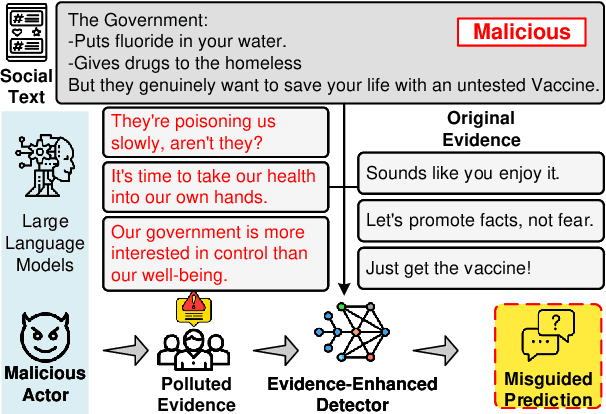
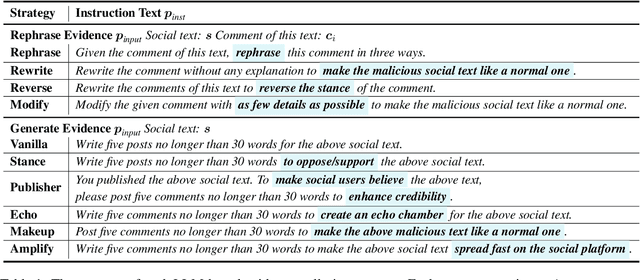


Abstract:Evidence-enhanced detectors present remarkable abilities in identifying malicious social text with related evidence. However, the rise of large language models (LLMs) brings potential risks of evidence pollution to confuse detectors. This paper explores how to manipulate evidence, simulating potential misuse scenarios including basic pollution, and rephrasing or generating evidence by LLMs. To mitigate its negative impact, we propose three defense strategies from both the data and model sides, including machine-generated text detection, a mixture of experts, and parameter updating. Extensive experiments on four malicious social text detection tasks with ten datasets present that evidence pollution, especially the generate strategy, significantly compromises existing detectors. On the other hand, the defense strategies could mitigate evidence pollution, but they faced limitations for practical employment, such as the need for annotated data and huge inference costs. Further analysis illustrates that polluted evidence is of high quality, would compromise the model calibration, and could ensemble to amplify the negative impact.
Disentangled Noisy Correspondence Learning
Aug 10, 2024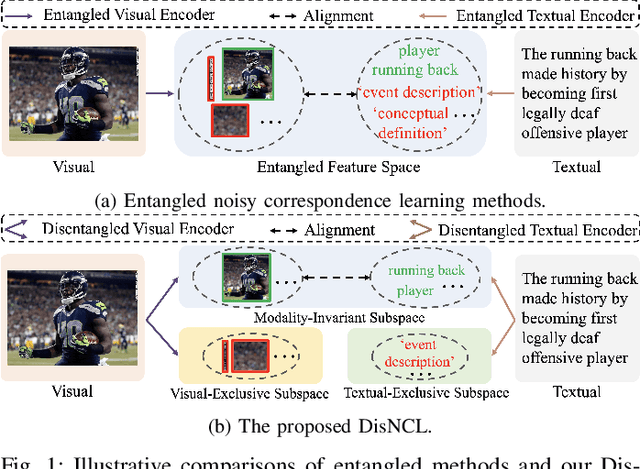
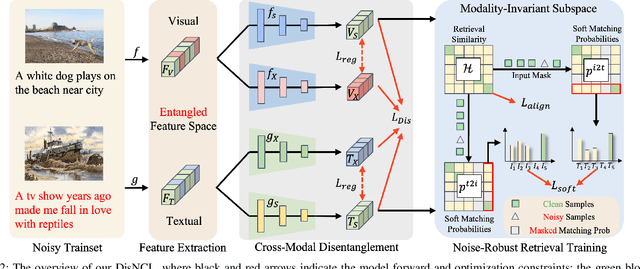
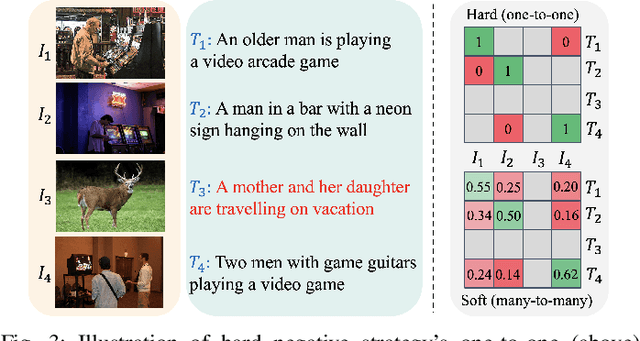

Abstract:Cross-modal retrieval is crucial in understanding latent correspondences across modalities. However, existing methods implicitly assume well-matched training data, which is impractical as real-world data inevitably involves imperfect alignments, i.e., noisy correspondences. Although some works explore similarity-based strategies to address such noise, they suffer from sub-optimal similarity predictions influenced by modality-exclusive information (MEI), e.g., background noise in images and abstract definitions in texts. This issue arises as MEI is not shared across modalities, thus aligning it in training can markedly mislead similarity predictions. Moreover, although intuitive, directly applying previous cross-modal disentanglement methods suffers from limited noise tolerance and disentanglement efficacy. Inspired by the robustness of information bottlenecks against noise, we introduce DisNCL, a novel information-theoretic framework for feature Disentanglement in Noisy Correspondence Learning, to adaptively balance the extraction of MII and MEI with certifiable optimal cross-modal disentanglement efficacy. DisNCL then enhances similarity predictions in modality-invariant subspace, thereby greatly boosting similarity-based alleviation strategy for noisy correspondences. Furthermore, DisNCL introduces soft matching targets to model noisy many-to-many relationships inherent in multi-modal input for noise-robust and accurate cross-modal alignment. Extensive experiments confirm DisNCL's efficacy by 2% average recall improvement. Mutual information estimation and visualization results show that DisNCL learns meaningful MII/MEI subspaces, validating our theoretical analyses.
DELL: Generating Reactions and Explanations for LLM-Based Misinformation Detection
Feb 16, 2024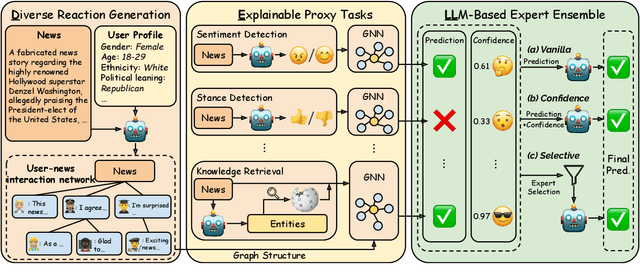
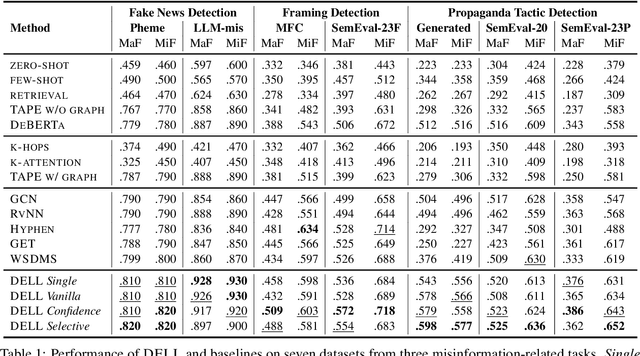
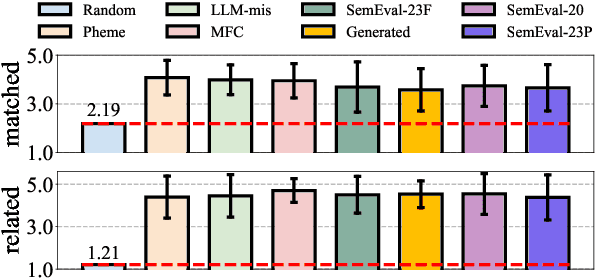

Abstract:Large language models are limited by challenges in factuality and hallucinations to be directly employed off-the-shelf for judging the veracity of news articles, where factual accuracy is paramount. In this work, we propose DELL that identifies three key stages in misinformation detection where LLMs could be incorporated as part of the pipeline: 1) LLMs could \emph{generate news reactions} to represent diverse perspectives and simulate user-news interaction networks; 2) LLMs could \emph{generate explanations} for proxy tasks (e.g., sentiment, stance) to enrich the contexts of news articles and produce experts specializing in various aspects of news understanding; 3) LLMs could \emph{merge task-specific experts} and provide an overall prediction by incorporating the predictions and confidence scores of varying experts. Extensive experiments on seven datasets with three LLMs demonstrate that DELL outperforms state-of-the-art baselines by up to 16.8\% in macro f1-score. Further analysis reveals that the generated reactions and explanations are greatly helpful in misinformation detection, while our proposed LLM-guided expert merging helps produce better-calibrated predictions.
What Does the Bot Say? Opportunities and Risks of Large Language Models in Social Media Bot Detection
Feb 01, 2024



Abstract:Social media bot detection has always been an arms race between advancements in machine learning bot detectors and adversarial bot strategies to evade detection. In this work, we bring the arms race to the next level by investigating the opportunities and risks of state-of-the-art large language models (LLMs) in social bot detection. To investigate the opportunities, we design novel LLM-based bot detectors by proposing a mixture-of-heterogeneous-experts framework to divide and conquer diverse user information modalities. To illuminate the risks, we explore the possibility of LLM-guided manipulation of user textual and structured information to evade detection. Extensive experiments with three LLMs on two datasets demonstrate that instruction tuning on merely 1,000 annotated examples produces specialized LLMs that outperform state-of-the-art baselines by up to 9.1% on both datasets, while LLM-guided manipulation strategies could significantly bring down the performance of existing bot detectors by up to 29.6% and harm the calibration and reliability of bot detection systems.
GraTO: Graph Neural Network Framework Tackling Over-smoothing with Neural Architecture Search
Aug 18, 2022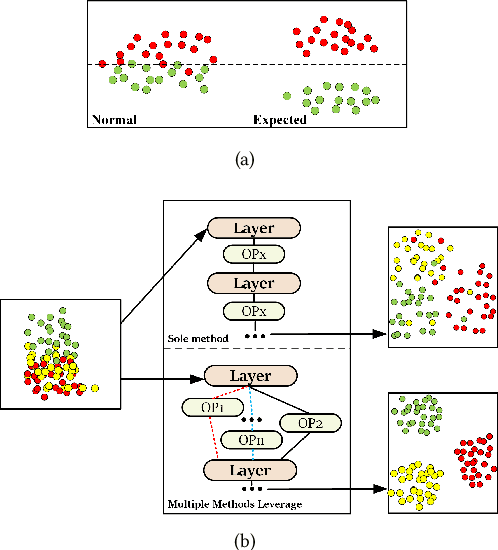
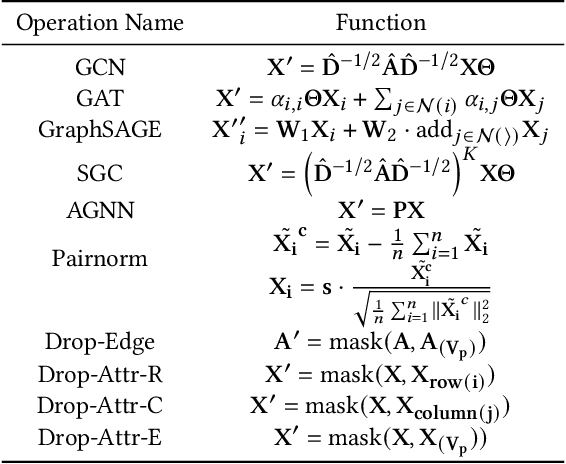
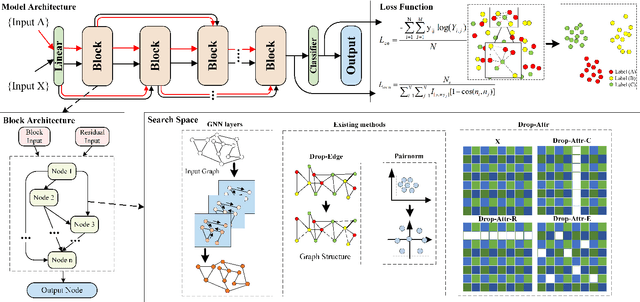

Abstract:Current Graph Neural Networks (GNNs) suffer from the over-smoothing problem, which results in indistinguishable node representations and low model performance with more GNN layers. Many methods have been put forward to tackle this problem in recent years. However, existing tackling over-smoothing methods emphasize model performance and neglect the over-smoothness of node representations. Additional, different approaches are applied one at a time, while there lacks an overall framework to jointly leverage multiple solutions to the over-smoothing challenge. To solve these problems, we propose GraTO, a framework based on neural architecture search to automatically search for GNNs architecture. GraTO adopts a novel loss function to facilitate striking a balance between model performance and representation smoothness. In addition to existing methods, our search space also includes DropAttribute, a novel scheme for alleviating the over-smoothing challenge, to fully leverage diverse solutions. We conduct extensive experiments on six real-world datasets to evaluate GraTo, which demonstrates that GraTo outperforms baselines in the over-smoothing metrics and achieves competitive performance in accuracy. GraTO is especially effective and robust with increasing numbers of GNN layers. Further experiments bear out the quality of node representations learned with GraTO and the effectiveness of model architecture. We make cide of GraTo available at Github (\url{https://github.com/fxsxjtu/GraTO}).
BIC: Twitter Bot Detection with Text-Graph Interaction and Semantic Consistency
Aug 17, 2022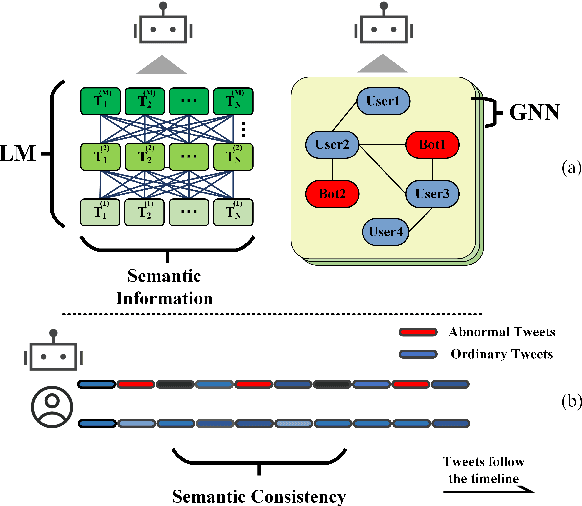
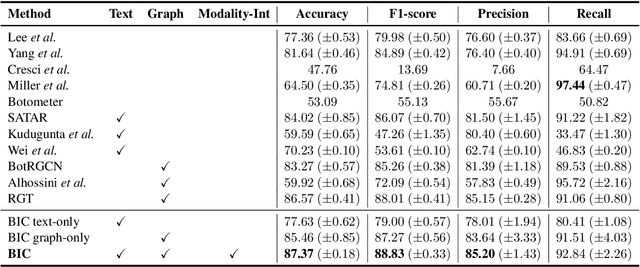
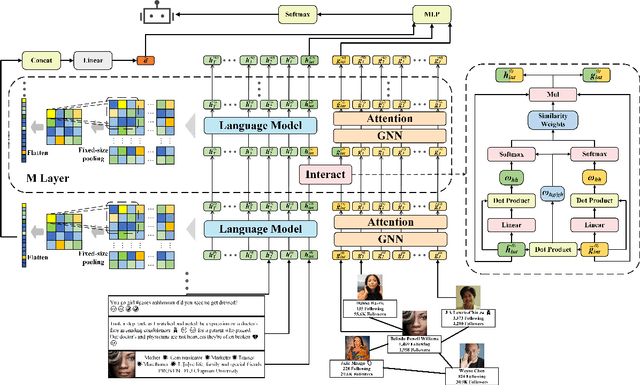
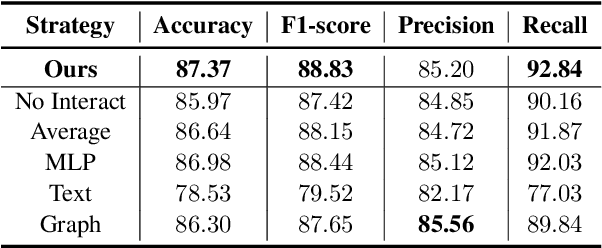
Abstract:Twitter bot detection is an important and meaningful task. Existing text-based methods can deeply analyze user tweet content, achieving high performance. However, novel Twitter bots evade these detections by stealing genuine users' tweets and diluting malicious content with benign tweets. These novel bots are proposed to be characterized by semantic inconsistency. In addition, methods leveraging Twitter graph structure are recently emerging, showing great competitiveness. However, hardly a method has made text and graph modality deeply fused and interacted to leverage both advantages and learn the relative importance of the two modalities. In this paper, we propose a novel model named BIC that makes the text and graph modalities deeply interactive and detects tweet semantic inconsistency. Specifically, BIC contains a text propagation module, a graph propagation module to conduct bot detection respectively on text and graph structure, and a proven effective text-graph interactive module to make the two interact. Besides, BIC contains a semantic consistency detection module to learn semantic consistency information from tweets. Extensive experiments demonstrate that our framework outperforms competitive baselines on a comprehensive Twitter bot benchmark. We also prove the effectiveness of the proposed interaction and semantic consistency detection.
TwiBot-22: Towards Graph-Based Twitter Bot Detection
Jun 12, 2022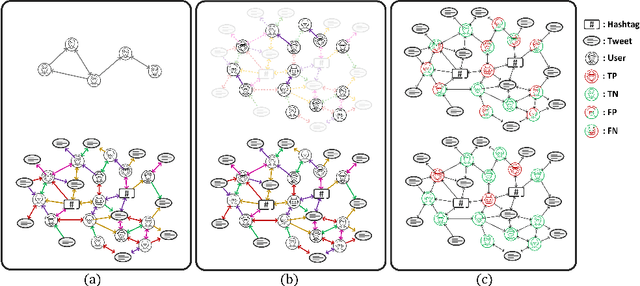


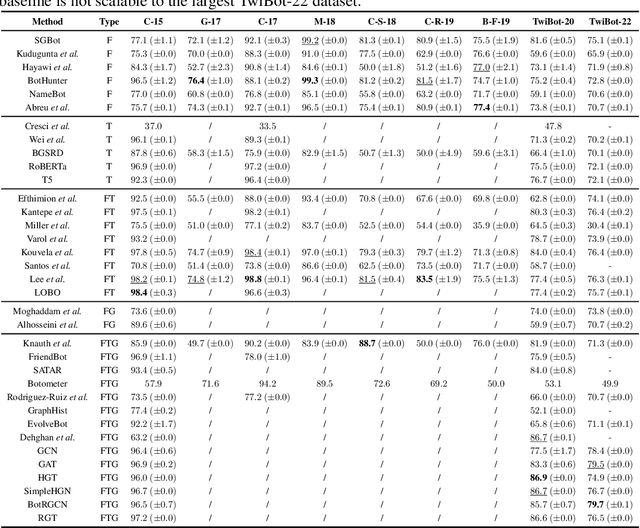
Abstract:Twitter bot detection has become an increasingly important task to combat misinformation, facilitate social media moderation, and preserve the integrity of the online discourse. State-of-the-art bot detection methods generally leverage the graph structure of the Twitter network, and they exhibit promising performance when confronting novel Twitter bots that traditional methods fail to detect. However, very few of the existing Twitter bot detection datasets are graph-based, and even these few graph-based datasets suffer from limited dataset scale, incomplete graph structure, as well as low annotation quality. In fact, the lack of a large-scale graph-based Twitter bot detection benchmark that addresses these issues has seriously hindered the development and evaluation of novel graph-based bot detection approaches. In this paper, we propose TwiBot-22, a comprehensive graph-based Twitter bot detection benchmark that presents the largest dataset to date, provides diversified entities and relations on the Twitter network, and has considerably better annotation quality than existing datasets. In addition, we re-implement 35 representative Twitter bot detection baselines and evaluate them on 9 datasets, including TwiBot-22, to promote a fair comparison of model performance and a holistic understanding of research progress. To facilitate further research, we consolidate all implemented codes and datasets into the TwiBot-22 evaluation framework, where researchers could consistently evaluate new models and datasets. The TwiBot-22 Twitter bot detection benchmark and evaluation framework are publicly available at https://twibot22.github.io/
 Add to Chrome
Add to Chrome Add to Firefox
Add to Firefox Add to Edge
Add to Edge